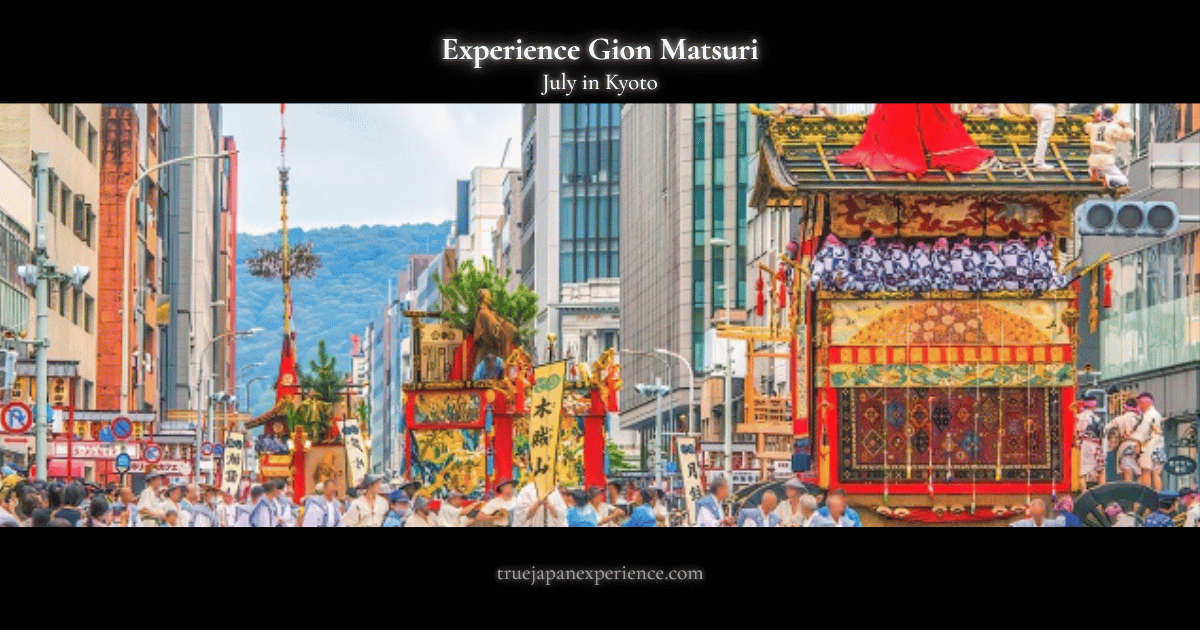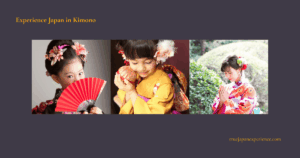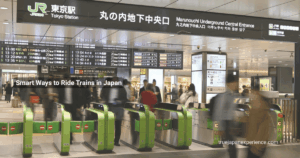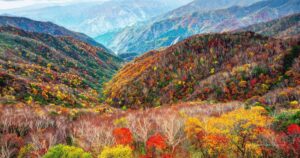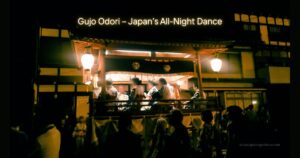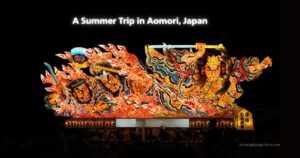Introduction
If you’re planning to visit Kyoto in July, there’s one event you can’t miss: Gion Matsuri.
This legendary festival fills the city with traditional music, colorful lanterns, and massive wooden floats. It’s a month-long celebration that blends sacred ritual with joyful street energy — and it has been going strong for more than 1,100 years.
You’ll hear the sound of “kon-chiki-chin” drifting through the streets. It’s the sound of summer in Kyoto.
What Is Gion Matsuri?

Gion Matsuri is the annual festival of Yasaka Shrine, located in Kyoto’s famous Gion district. It began in 869 AD, when an epidemic struck Japan.
To calm the gods, people gathered 66 spears representing each province and carried portable shrines (mikoshi) to a sacred garden called Shinsen’en. This ritual was called Goryoe.
Over time, this became a yearly tradition. By 970 AD, Gion Matsuri was held every summer. It has continued for over a thousand years and now includes elaborate processions, traditional music, and spiritual ceremonies.
When Is It Held?
Gion Matsuri takes place every year from July 1 to 31.
The festival is full of events throughout the month, but the most famous ones are:
・July 17 – Saki Matsuri (First Procession)
・July 24 – Ato Matsuri (Second Procession)
・July 14–16 and July 21–23 – Yoiyama nights (pre-parade festivities)
Highlights of the Festival
Gion Matsuri is packed with unique events, rituals, and cultural moments that span the entire month of July.
Among them, three experiences stand out the most: the grand float processions, the lively nighttime street festival, and the spiritual meaning behind each performance.
Let’s take a closer look at these highlights.
Yamaboko Junko – The Float Processions
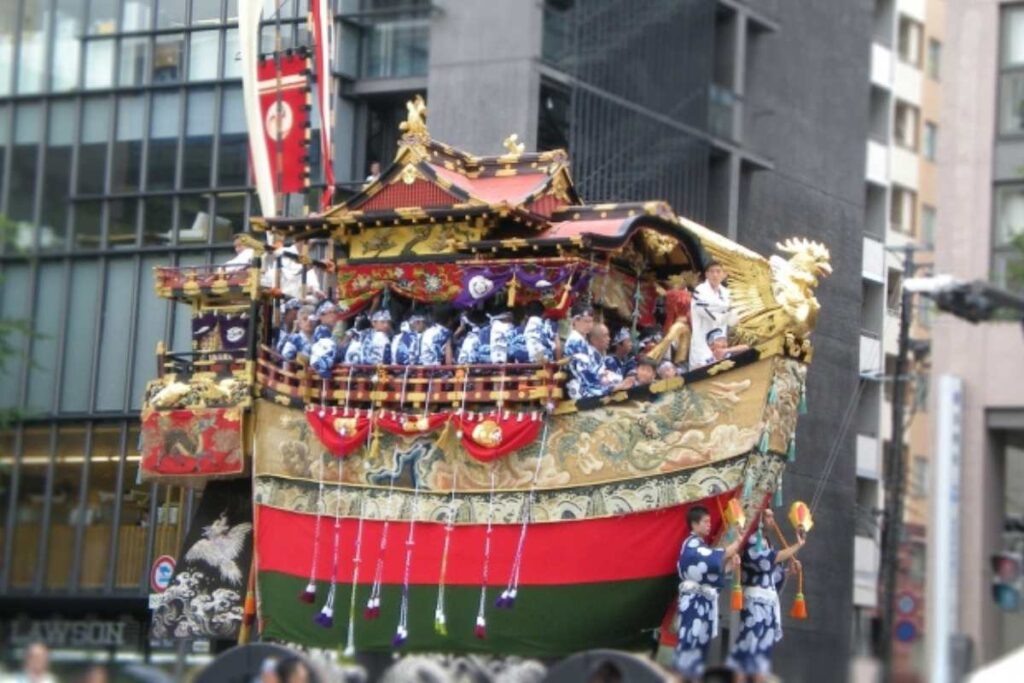
The highlight of Gion Matsuri is the grand float parade known as Yamaboko Junko.
These magnificent processions take place twice — on July 17 and July 24 — and showcase Kyoto’s finest craftsmanship, history, and tradition.
Dozens of floats, each representing a local neighborhood, roll through the city in a spectacular display of color and culture. Here’s what makes them so special:
・Huge wooden floats parade through the city
・Each one is built without nails — tied together with rope
・They are 2–3 stories tall and weigh up to 12 tons
・Many floats are decorated with treasures, paintings, and textiles
・Some display figures from Japanese myths or Chinese legends
・Each float is believed to bring a specific type of good luck
The leading float, Naginata Hoko, always comes first.
It’s the only float that carries a real child, called a chigo, considered a messenger of the gods.
Yoiyama – Nighttime Street Festivals
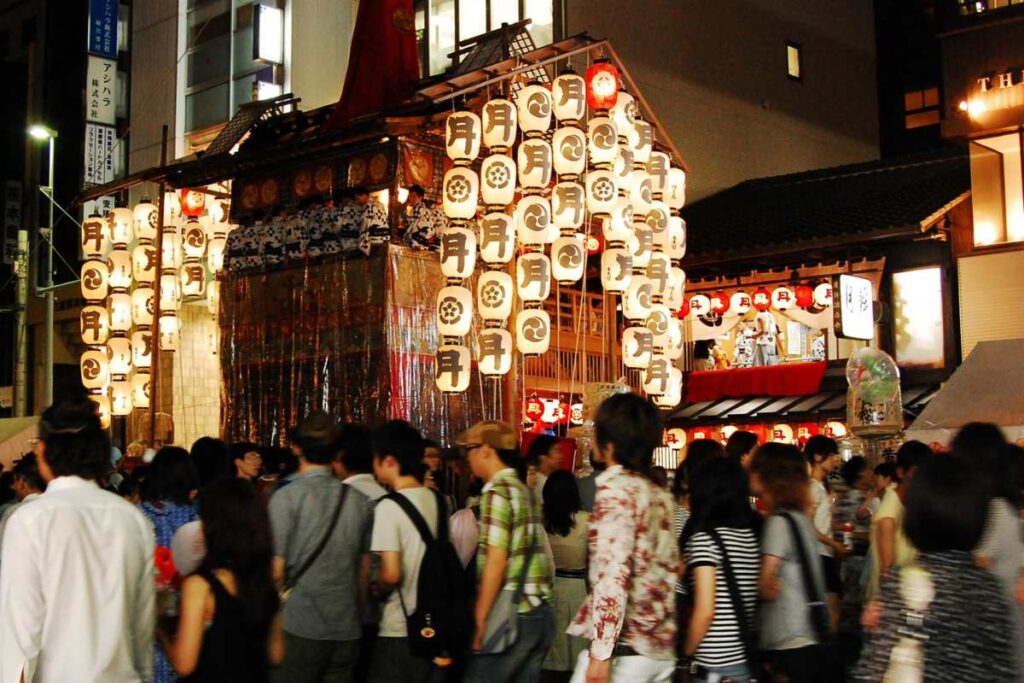
The three nights before each parade are called Yoiyama.
・Streets are closed to traffic and lined with glowing lanterns
・Floats are on display, beautifully lit and surrounded by crowds
・Locals open their homes to show family heirlooms (Byobu Matsuri)
・Food stalls offer takoyaki, yakisoba, and traditional sweets
・People dress in yukata (light cotton kimono) and walk with fans in hand
Yoiyama is the perfect time to experience Kyoto’s summer charm.
How to Watch the Procession
There are two ways to enjoy the float processions:
grab a reserved seat for a guaranteed view, or find a good spot along the route and soak in the street energy.
Tickets can be tricky to get, though — so if you’re aiming for a seat, it’s best to book early!
Paid Seating
If you want a secure and comfortable view of the float processions, paid seating areas are available each year.
・Seats are usually set up along Oike Street, between Kawaramachi and Shinmachi.
・However, the exact location may change slightly depending on the year.
・The latest parade routes and seating maps are published on the Gion Matsuri Official Website, so it’s a good idea to check in advance.
Tickets can be booked online, either through this travel site for Kyoto or via travel agencies.
In recent years, guided tours for international visitors have become more common — often with multilingual support and guaranteed seats.
Paid seats do sell out quickly, especially for the main parade dates.
If you’re hoping to sit and relax while watching the floats go by, early booking is highly recommended.
Free Viewing and Yoiyama Experience

You don’t need a ticket to enjoy Gion Matsuri — there are plenty of ways to experience it for free.
If you want to see the floats in motion, head to the streets on parade day.
Popular viewing spots include:
・Shijo–Kawaramachi intersection
・Kawaramachi–Oike intersection
・Along Shijo Street and Kawaramachi Street
These areas are famous for the dramatic “Tsuji-mawashi”, where massive floats turn the corners.
The energy is unforgettable, but the crowds can be overwhelming.
There are no hidden spots, so it’s best to arrive early and be prepared to wait.
Bring water, wear a hat, and take heat protection seriously — Kyoto in July can be dangerously hot.
If you prefer a more relaxed atmosphere, visit during the Yoiyama nights.
During the Yoiyama period, the floats are displayed throughout the neighborhood streets and lit with lanterns at night.
You can walk right up to them, admire their incredible craftsmanship, and take photos from just a few steps away.
Both the daytime processions and nighttime displays are free to enjoy.
Whether you’re standing among the crowds during the parade or strolling through lantern-lit streets at night, Gion Matsuri offers something unforgettable.
After the Parade
Once the procession ends, the floats return to their neighborhoods.
If you walk along Shinmachi Street, just south of Oike, you can see the floats up close as they quietly return.
・Less crowded
・Slower pace
・Great for photography and relaxed viewing
Tips for Enjoying Gion Matsuri
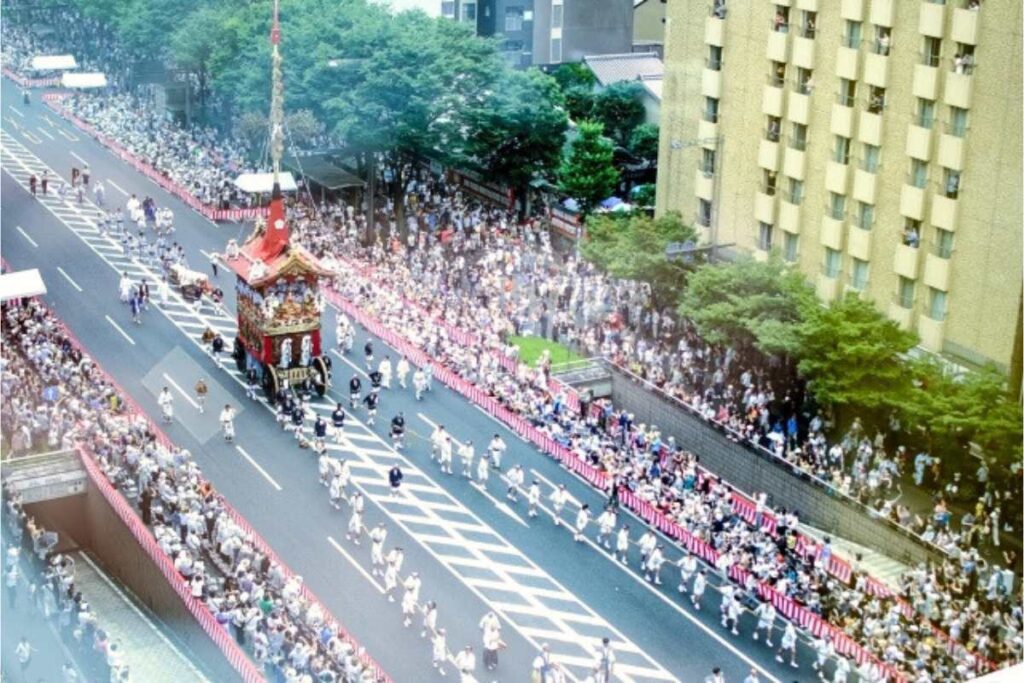
Gion Matsuri is a once-a-year experience, but July in Kyoto can be intense — especially with the crowds and heat.
Here are some practical tips to help you stay comfortable and make the most of your visit.
・Stay hydrated.
Kyoto’s summer is hot and humid. Bring a water bottle and drink often, especially during long walks or while standing in crowded areas.
・Wear light clothing or rent a yukata.
Breathable fabrics like linen or cotton help you stay cool. If you want to join the festival spirit, yukata rentals are available throughout Kyoto.
・Bring a fan, towel, and sunscreen.
A folding fan or portable fan can make a big difference. A small towel is useful for wiping sweat, and sunscreen is essential for long days outdoors.
・Use public transportation.
Many streets are blocked for the festival, so trains and subways are more reliable than taxis or buses. Be ready for stations to be crowded.
・Expect big crowds — and go with the flow.
The festival attracts hundreds of thousands of visitors every year. Patience is key. Arrive early, stay alert, and enjoy the energy of the moment.
・Book in advance.
Hotels near the city center fill up quickly, and paid seating often sells out weeks ahead — so make your reservations early.
Plan Your Visit to Gion Matsuri
Gion Matsuri isn’t just a tourist attraction — it’s a living tradition, passed down through generations in Kyoto.
The floats, the music, the spiritual meaning, and the festive atmosphere all combine to create something truly unforgettable.
If you’re visiting Japan in July, this festival is one of the most powerful ways to connect with local culture.
But because it’s such a major event, planning ahead is essential.
Follow updates in English here:
👉 Gion Matsuri Official Website
👉 this travel site for Kyoto
Whether you’re coming for the floats, the food, or the once-a-year energy — Gion Matsuri is a memory you won’t forget.
Add it to your July itinerary, and experience Kyoto at its most festive.
